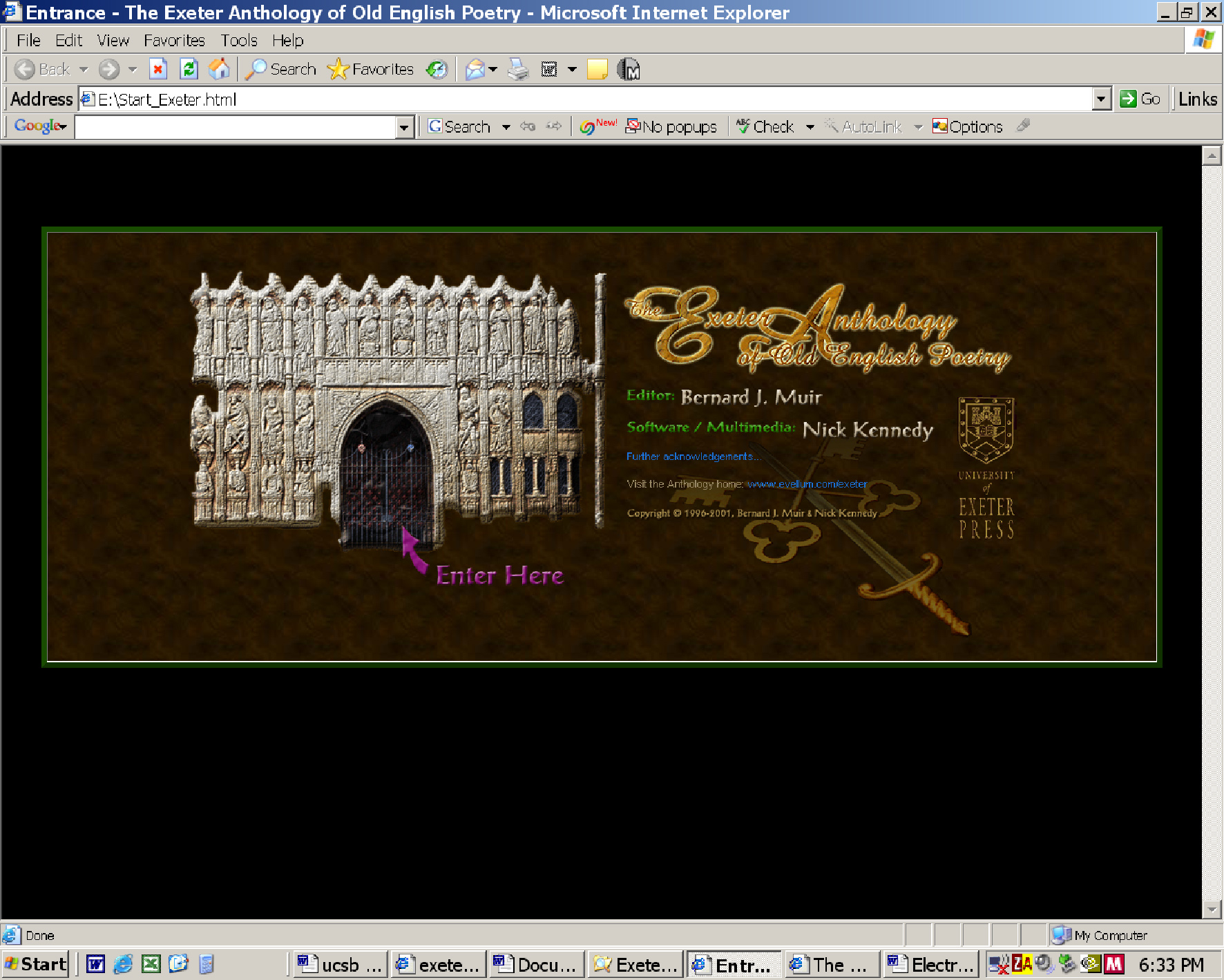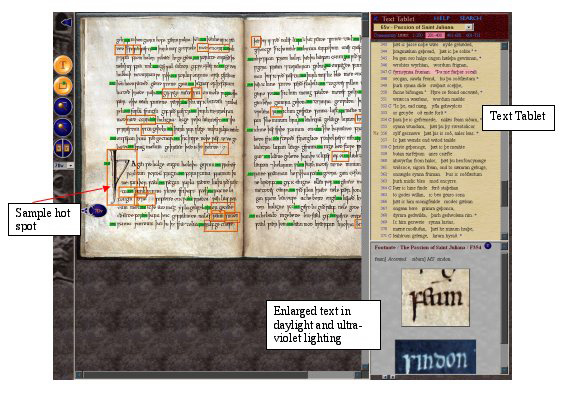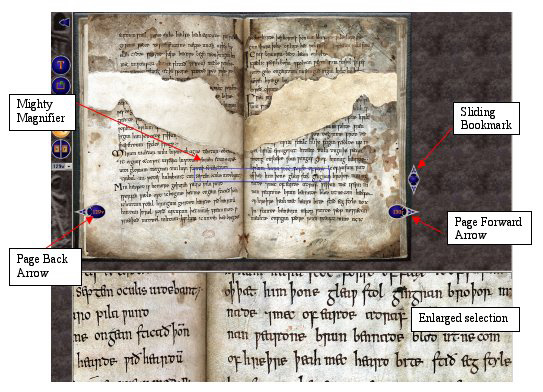Related Categories: New Approaches to Reading Print Texts
Summary:
The Exeter Dean and Chapter MS 3501, or “The Exeter Book,” is the oldest of four collections of Anglo-Saxon poetry. It is believed to have been produced in southwest England, probably between 965 and 975 (Muir 1).
Digital images of the Exeter Book were produced in 1996, and from these images, a “virtual manuscript” has been produced. “The Exeter Anthology of Old English Poetry” is edited and compiled by Bernard J. Muir and Nick Kennedy and produced in July 2006. It contains interactive facsimiles, a page viewer, codicological report, historical and cultural materials, and short audio readings of selected poems.
Description:
While examples of Old English poetry survive in a number of Anglo-Saxon manuscripts, the Exeter Book is one of four surviving sources comprised wholly of Anglo-Saxon poetry. It appears to have been copied by a single scribe during the late 10th century and includes both religious and secular poetic texts. It contains about one sixth of all Old English poetry, the most famous of which are “The Wanderer,” “The Seafarer,” “Widsith,” “Wulf and Eadwacer,” “The Wife’s Lament,” and a large collection of riddles. The manuscript, though well preserved on the whole, has lost a number of quires and has suffered severe damage in several places. It is now housed at the Exeter Cathedral Library in Exeter, England.
After the appearance of The Exeter Anthology of Old English Poetry in 1994, an electronic facsimile of the Exeter Book was planned. In July of 1996, high resolution digital images of the manuscript were made at the University of Exeter. Each archived image, now housed at the University of Melbourne, is approximately 100 MB in size. The digitized images were stored on forty-seven CDs that were burnt on site by the editors, Bernard J. Muir and Nick Kennedy. The images were then prepared by Graeme Smith.
The Exeter Anthology CD is a web-based, multimedia application that gives users access to the book in the form of a “virtual manuscript”. The program includes a fully cross-referenced (hypertext) version of The Exeter Anthology of Old English Poetry, which is tied to the virtual manuscript. Audio readings of selected poems in Old English and in Modern English translation are also included as well as Gregorian chants that are associated with some of the lyrics. A computer-generated movie describes the history of the Exeter Book as well as its restoration processes.
The CD is organized according to four navigable categories: the Exeter facsimile, historical context, audio recordings of the poems, and a page viewer. The facsimile appears as a manuscript on the screen, allowing the reader to flip from page to page as if it were a book. The reader can open hotspots on each page, which, when clicked, opens a footnote. These footnotes are often linked to scholarly commentary and contain hyperlinks to a Bibliography and Commentary. The Bibliography is a comprehensive catalog of all Exeter scholarship, while the Commentary will include a discussion of critical works that appeared between 1994 and 1999. Likewise, a box with the enlarged text appears as it was captured with bright daylight and ultra-violet lighting. Green squares throughout the text can be clicked to view each line of the text as it appears in the modern, edited edition of The Exeter Anthology. These lines are viewable in the Text Tablet. Within the text tablet is a search feature that allows the reader to search all instances of a word in the Exeter Book and navigate throughout the manuscript. Likewise, the Text Tablet contains a dropdown menu with a listing of all poems in the manuscript. These shortcuts allow the reader to search the manuscript according to poem.
In addition, the facsimile has two magnifying features: Mini Magnifier and Mighty Magnifier. By clicking on the Mini Magnifier, a square magnifying glass appears above a portion of the Manuscript Facsimile, allowing for closer scrutiny. By clicking on the Mighty Magnifier, a rectangular box appears across one complete line of the manuscript. At the same time, the magnifier opens across the bottom of the screen in a window showing an enlargement of the selected line. A thumbnail window can be accessed from the sliding bookmark, which allows the viewer to see all double openings of the manuscript.
Bernard Muir has found many alterations to the poetic texts beyond the four hundred new readings listed in the apparatus of the first edition of The Exeter Anthology (a printed edition of the manuscript). These will be detailed in the revised second edition, which can be purchased with or without the CD.
Research Context:
The cultural, technological, and scientific aspects of this project touch on Medieval Studies, Computer Science, and Library Science. More broadly put, this project brings together the humanities and the sciences, medieval studies and modern technology. Consequently, this project is relevant to History of the Book, New Media Studies, and reading technologies.
Technical Analysis:
This information is unavailable at this time.
Evaluation of Opportunities/Limitations for the Transliteracies Topic:
The Exeter Anthology is a cutting-edge example of both the practicality and the aesthetics of virtual reading. Not only can the reader take advantage of a text that is networked to ancillary reading and navigational tools, but the reader feels like she is actually interacting with a medieval text and its world of use and production. This movement towards integrating the expectations and mechanics of traditional reading into the production of electronic facsimiles is an important step towards making people want to read online.
Likewise, the search tools of the CD move beyond traditional glossaries and magnifying viewers. They situate the Exeter manuscript in apposition to its cultural and critical tradition. For example, the Advent Lyrics in the Exeter Book are based on Gregorian chants sung at vespers during Advent season. One audio file in the Exeter CD is a recitation of one of these Advent Lyrics, which is complemented by several Gregorian Chant audio files. Unlike the traditional experience of working with medieval texts, the facsimile–not the edition—functions as an accessible point of origin for study.
Resources for Further Study
This CD was released in July 2006, and little information is available at this time.
Point(s) for Expansion
- Bernard J. Muir, The Exeter Anthology of Old English Poetry: An Edition of Exeter Dean and Chapter MS 3501, 2 vols. (Exeter, 1994), p. 1.
The Exeter Anthology is part of a concerted effort to digitize medieval manuscripts. Others include:
- “Electronic Beowulf,” Kevin Kiernan (ed.). British Library/U Michigan Press, 1999.
- A digital facsimile of Oxford, Bodleian Library, MS. Junius 11, Oxford : Bodleian Library, University of Oxford, 2004.
- Les Tres Riches Heures du duc de Berry, CD, Réunion des musées nationaux, 2004.
- Bayeux Tapestry Electronic Resource, Leicester, UK : Scholarly Digital Editions, 2003.
- The electronic texts and concordances of the prose works of Alfonso X, El Sabio, Madison, WI. Hispanic Seminary of Medieval Studies, 1997.
A number of research libraries that house aging manuscripts have begun to digitize all or portions of their collections:
- The Bodleian Library’s digital facsimiles include not only medieval manuscripts, printed ephemera, and 18th-19th century journals, but also an image catalog.
- Berkeley’s Digital Scriptorium is a database of medieval and renaissance manuscript images from many institutions. These institutions include Berkeley, Colombia University, University of Texas, Austin, New York Public Library, Houghton Library (Harvard University), and Walsh Library (Fordham University).
- The Parker Library, Corpus Christi College Cambridge has established a prototype website called Parker on the Web that currently offers a limited selection of web images from the CCCC manuscript collections.



